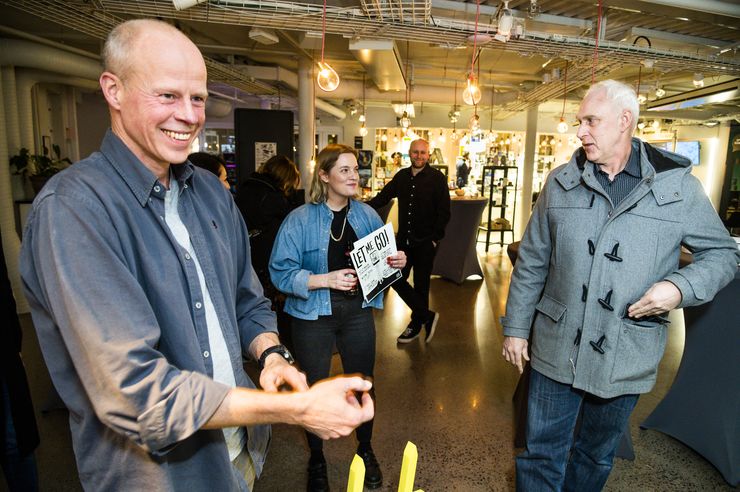“It can be difficult for people to get rid of old phones, which end up lying around in a drawer at home”, says Matilda Wallén, one of the students organising Gravöl. “You can hand them in to a recycling station – but what happens to them then? Electronic waste often ends up in underdeveloped countries where children work to recycle the materials, which may contain harmful substances. Furthermore, mining is expensive, has a severe impact on the climate, and affects both animals and people. It’s a better idea to use metal that is already out of the ground, such as the metal in old mobiles.”
 Photo credit THOR BALKHEDPeople have feelings for their phones
Photo credit THOR BALKHEDPeople have feelings for their phones
The background buzz of people chatting is regularly interrupted by applause when someone places a phone in the yellow cradle. Göran Palmquist is one of them. “My wife read about the event on Facebook. So I picked out some old mobiles and came”, he says and buys himself a beer. It is, after all, a wake. “I don’t think it’s difficult to hand them in: I’m not emotionally attached to them, and they don’t contain any sensitive information.”
But it is true that many people find it difficult to say goodbye to their old phones. In an earlier course, the students looked at how people relate to their mobiles. It became clear that some people have feelings for their phones – we do live extremely close to them. And some people are worried about what happens to the information in old phones. This is why they phones end up at home, or passed on to children or parents so that they remain within the family.
“I love this phone: it’s so small and handy. If it wasn’t broken, I would keep it”, says Jonas Löwgren, who teaches visual media on the master’s programme in design, putting the phone into the cradle. “This is a great event, and the cradle is a brilliant idea.”
A societal challenge
The event is one component of the first studio course in the master’s programme in design. Students were given the task of examining various societal challenges.“Our first idea was to organise a ‘repair café’. But then we came up with the idea of what to do with old mobiles”, says Matilda Wallén. “Reuse and recycling are, of course, major societal challenges. We had studied ‘e-waste’ in an earlier course, and so we decided to combine two things into one event.”
What happens to the mobiles you collect?
“They are bought by a company. The price for a reasonably new model in working condition can be as much as SEK 800. The company repairs the phones, where possible”, says Matilda Wallén. “The others have a value as scrap of SEK 50 per kilogram. We don’t really generate much profit, but the money we do make is donated to the Swedish Society for Nature Conservation.”
“We wanted to be in a public place, somewhere the general public could easily come. And the management at Visualization Center C were extremely positive.”
The purpose of Gravöl was not only to collect old phones: it was equally to inform the general public about how mobiles and metals are related to environmental challenges. The evening’s two speakers both had connections to LiU’s research into sustainability.
After the event, a lot of people have been in contact, wanting to hand in old mobiles. So the initial numbers may become higher. The students are looking for a permanent solution in which the cradle can be made available to the general public.
The group that arranged the event comprised students Matilda Wallén, Solith af Malmborg, Dong Wang and Mina Mani Kashani. The course they are taking is Studio 1: Repair, and is part of the master’s programme in design.
Translated by George Farrants